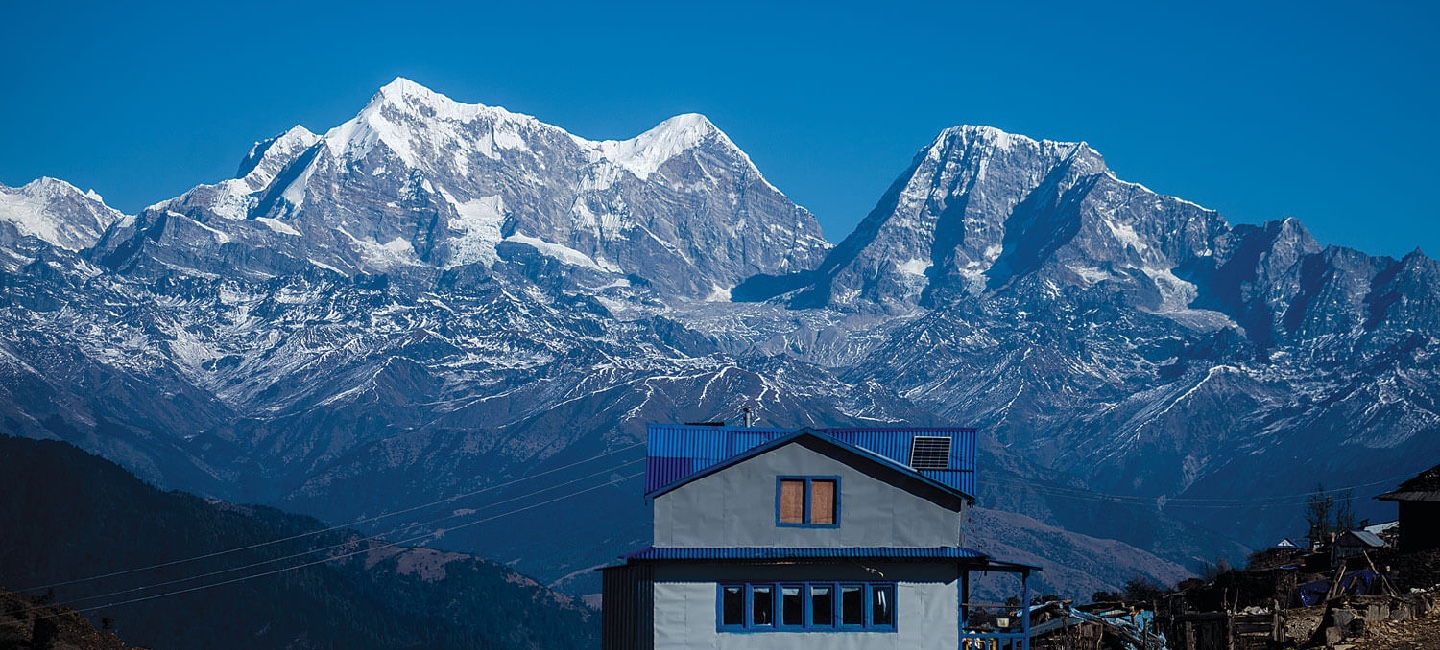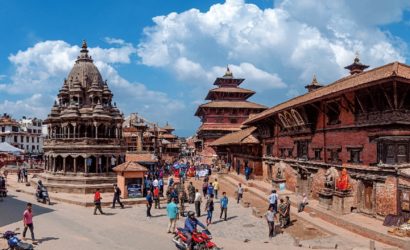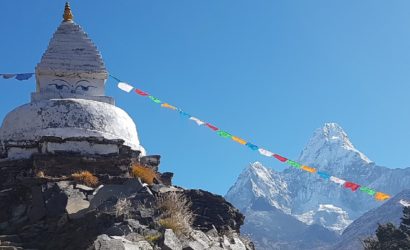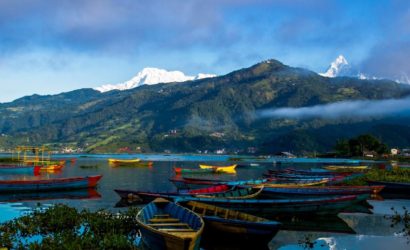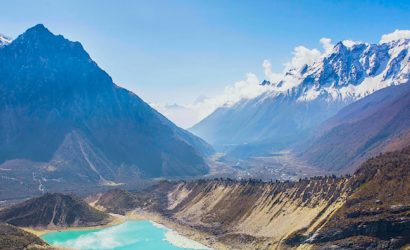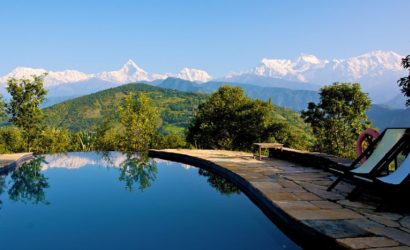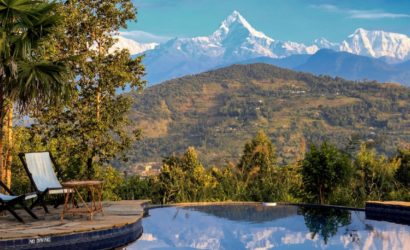Jiri to Everest Base Camp Trek is a highly praised trekking route of the Everest region. It was in 1953 when two renown figures Sir Edmund Hillary and Mr. Tenzing Norgey Sherpa had taken the same route for the Mt. Everest expedition.
After a scenic drive of eight hours from Kathmandu to Jiri, our trek begins the following morning, passing through the lower parts of the Everest region, which are relatively undeveloped compared to the northern side of the Namche Bazaar district. This allows hikers to experience many traditional cultural and local aspects.
The trail runs through numerous villages of various ethnic groups including Tamang, Jirel, Rai and of course, the Sherpa. Walking along this trek involves many up and down hills with the trail being well maintained in most villages with tea houses and good campsites.
Being a combination of two treks that passed from Namche Bazaar, the Khumbu area’s main trading village continuing through Gokyo Valley, Chola Pass, Lobuche, Everest Base Camp and up to Kala-pattar then back down to Tengboche Monastery and back to Lukla. From Lukla, we also offer the popular Everest Base Camp Trek.
Jiri to Everest Base Camp Trek Difficulty
Everest Base Camp trekking takes some serious effort. But to complete this journey, do you need to be in great shape? The simple answer is NO!. You can go at a slow speed, your own pace and still make it Jiri to Everest Base Camp Trek. Going slow is actually going to assist you acclimatize better.
You should be able to walk 8 to 12 km in a day. Be able to walk for at least an hour on intense inclines. Unless you plan to hire a porter, you can carry a bag while doing all of this.
When you’re ready, it’s hard to measure. It’s not like a Marathon or anything else you’ve most likely ever done. There were people on the trail who were overweight and going incredibly slow but to celebrate the achievement they were right there with us at the base camp.
We recommend doing some 4 to 6 hours treks at home so your body gets used to this kind of workout duration. Start about 5-7 weeks before you leave and build up time and distance slowly so that your body is comfortable with trekking for a solid 6 hours by the end of it.
Trek Highlights
- Visit Everest Base Camp and experience the camaraderie as climbers attempt the world’s highest peak
- Highly experienced Sherpa leaders
- Stand on the summit of Kala Patar at 5,645 m. (18,519 ft) for stunning views of Everest
- Visit ancient monasteries and receive a blessing from a monk/lama
Upon your arrival in the Kathmandu airport after completing your custom formalities Visa, etc. pick up your luggage and look for our airport representative from Himalaya Discovery, who will display your name on the board at the arrival gate.
You will be greeted by our representative and transferred to the hotel by private tourist vehicle. Overnight at hotel in Kathmandu.
Today is free for sightseeing in Kathmandu. You may wish to visit Durbar Square in the heart of the old city where the old Royal Palace, with its intricate woodcarving is located. The whole area is a maze of temples and images.
Leading away from the square in all directions are narrow alleys, full of the most amazing variety of shops and stalls. Some of these landmarks are considered World Heritage Sites including the historic Bhaktapur Durbar Square, the famous ‘Monkey Temple’ Swayambhunath and Buddhists shrine Buddhanath which is one of the largest Stupas in the world.
There will also be a full trip briefing today with gear check. In case you need to hire or buy equipment locally there will be time to do this today. Overnight in Kathmandu.
Today we take an early morning drive to jiri, scenic bus ride up the Sun-Kosi river valley to the town of Jiri, the trail-head of the Everest trek and our first camp. Overnight at guesthouse.
We start our trek at the paved road in Jiri, after crossing a stream the track leaves the road and starts to climb uphill through trees to several wooden bhattis at the tiny settlement of Bharkur.
We keep climbing to the Mali Danda (2440m), from where there are good views of the peaks near Rolwaling. Away from Mali Danda we drop into the Khimti valley through the sparsely populated Sherpa settlement of Mali at 2220m and continue our way to the crossing of the Yelung Khola river at 1800m. After crossing the Khimti Khola rivere on another suspension bridge we will reach Shivalaya It takes approximately 4 hrs.
We will have lunch here, from Shivalaya, at first steep ascent towards the pass at Deorali (2710m). On our way to this pass we will cross numerous streams and walk through the villages of Sangbadanda (2180m), Khasrubas (2330m) & Mahabhir (2590m). From Deurali pass we steeply drop on stone steps through fields & pastures Bhandar. Overnight at guesthouse.
From Bhandar the trail descents through the lower fields of the village, passing the small settlements of Doharpa and Baranda before crossing the Tharo Khola River on a steel bridge at 1480m.
As we follow the east bank of the river we climb towards Kinja (1630m), a settlement populated by Newars and Magars. As we leave Kinja we start to ascent steeply towards Chimbu and continue on towards Sete where we will spend the Overnight at guesthouse.
From today our trek is completely in Sherpa country and starts by climbing from Sete to the top of the 3535m. high Lamjura Bhanjyang. The way is scenic and varied through forests of rhododendron, magnolia, maple and birch. This section of the trail is also well known for spotting birds like sunbirds.
Lamjura Bhanjyang is the highest point on the trek between Jiri & Namche Bazaar & is marked by a tangle of stones, kindling & prayer flags. On the eastern side of the pass the route descents steeply for about 400m through fragrant fir & hemlock forests, then levels out passing the small village of Tragdobuk (2830m).
Continuing our way down we will enter in Junbesi, a impressive Sherpa village among beautiful surroundings. Overnight at guesthouse.
After leaving Junbesi in the morning we cross the Junbesi Khola river and then climb steeply uphill, contouring above the houses to the end of the ridge. From here we have excellent views of Everest, Thamserku, Kantega and Mera Peak.
This is the first view of Everest on this trek, although the lower peaks in the foreground seem to dwarf the higher, more distant mountains. After passing the Ringmo Khola river, the trail ascends to Ringmo village, with its abundant fruit orchards. Beyond Ringmo we climb to the Trakshindu La pass (2930m), where we can see the isolated monastery of Trakshindu, a superb example of Sherpa architecture.
We now descent through forests of conifer and rhododendron, passing sheepherds huts & alongside the trail until we reach Nhuntala Overnight at guesthouse.
From Nhuntala the descent continues to the Dudh Kosi (Milk River) and cross this river using a 110m long suspension bridge (1500m).Our trek then climbs out of the river valley through fields of barley, wheat & corn to the sprawling Rai village of Jubing (1680m).
We continue to climb up a ridge to a Sherpa village named Khari Khola (2010m). Beyond this village we climb past some water driven mills to Bupsa. Overnight at guesthouse.
Our trek will start with a gentle climb, passing the village of Kharte & continues on through forests populated by monkeys. From this part of the trek we can esteem views of Cho Oyu (8201m). We keep climbing the rim till we reach the teashop on Khari La pass at 2840m.
From the pass, the trail downhill into the deep gorge of Paiya Khola. After crossing this river on a wooden bridge we reach the small settlement of Puiyan (2730m). The trail climbs up and down for about an hour after Paiya to a rim that offers a good view of the Khumbu region and then descents 500m towards Surke (2290m).
Continuing our trail upwards again, we climb through a jumble of boulders, passing some wonderful mani walls until we reach the village of Chablung. Overnight at guesthouse
After leaving Chablung we will cross the Tharo Kosi (2580m) river on a local-style suspension overpass. The trail climbs a bit towards Ghat (2600m), we will cross a ridge marked with painted mani stones & climb to Phakding. From Phakding we follow the valley of the Dudh Kosi (milk river), staying on the west bank of the river.
We climb steeply over a stony rim towards Benkar (2630m). From here the trail continues alongside the river. All along this part of the trail, villages are interspersed with magnificent forests of rhododendron, magnolia and giant firs. In both the early autumn & late spring, the flowers on this portion of the trek make it a beautiful walk.
We cross the Kyashar Khola River and climb out of the valley to Monjo (2840m). Just away from Monjo the trek enters the Sagarmatha (Everest) National Park, which was well-known in 1976 to guard a 1148 sq km area surrounding Mt Everest.
Away from the national park entrance station. After crossing this river a few times while climbing our way up the valley we will reach Namche Bazaar (3440m). Namche Bazaar is the main trading centre in this region & features numerous shops, hotels and restaurants. Overnight at guesthouse.
Acclimatization is important before proceeding higher. Today we will rest or take a day hike through the villages of Khunde and Khumjung. We start with a steep one-hour climb to the Syangboche airport (3720m), from where we will slowly ascent towards Khunde passing numerous chorten (stone Buddhist monuments).
From Khunde we follow the trail eastwards to Khumjung, the largest village in Khumbu, at the foot of the sacred peak Khumbila. After enjoying lunch here we will follow some ascent and continue descending trail to Namche Bazaar. Overnight at guesthouse.
We will leave the village for a climb to the top of a ridge and level mountain path that offers an excellent panorama of Thamserku, Kantega, and Kusum Kangru. To the right there is a steep cliff that drops down to the Dudh Kosi, slightly visible on the valley floor below.
As we make our way around a branch ridge, Am Dablam, Everest, Lhotse, Nuptse, suddenly appear. After a gentle descent the mountain path ends; we will approach to the fork leading to Gokyo. Now we descend past two tea houses and through the village of Trashinga.
Though we cannot see it, we can hear the Dudh Kosi and soon we descend to the river and enter at Phunki Tenga. It is a long climb to Tyangboche. the first half is chiefly steep. As we climb through the forested zone, the favoritism eases and impressive view appears.
Continue climbing the mountainside transversely until we approach to the stone gate built by lamas which marks our entry into Tyangboche. we might use the large plateau in front of the splendid monastery as our campsite.
There are a lodge and hotel managed by the National Park Service. Tyangboche is an important lookout point on this track, and the sunset on Everest and Ama Dablam is especially beautiful. Overnight at guesthouse.
After having breakfast, we leave Tyangboche and the Khumbu Mountains backdrop-and descend a rhododendron covered area to emerge to a pleasant level area. Pass a long Chorten stone wall to enter the village of Deboche.
Leaving to Minlinggo and leave the mountain path to cross over a suspension bridge to the left bank of the Imja Khola. Climb the mountain path while looking up at Ama Dablam and Kantega as they appear on the opposite bank.
Ascend the Chorten-lined route, approach to a fork, the upper path passes Pangboche monastery, take the lower path to Pangboche and its stone wall-enclosed potato field. Pass through the village and cross a stream to a path shirking a rocky area to terraced hills along the riverbank.
The trails climb slowly, winding above the Imjatse River, to a big Mani Stupa. From here, the walk is fairly moderate as we enter the Imjatse Valley beneath the mighty peaks of Ama Dablam, Nuptse and Lhotse with views of the eastern snow capped mountains including the Island Peak or Imjatse.
Dingboche is a beautiful patchwork of fields enclosed by stone walls protecting the crops of barley, buckwheat and potatoes from the cold winds and grazing animals. Overnight at guesthouse.
The onward journey leads north for ups to 40-minutes until we approach to a chorten-prayer Stupa. The trail is gentle looking down to Pheriche village below. We will walk offers views of the Mt.Tawache, Ama Dablam and to the north-Pokalde Kongma-tse and the great wall of Nuptse.
After two & half hours walk,the trail from Pheriche joins near Dukla (4610m) before a small wooden bridge over the river of Khumbu glacier. Stop at Dukla, for lunch, before continuing for an hour up a steep hill to the top, where there are views of Mt. Pumori and other peaks west of Everest.
After a short break, continue trekking up to Lobuche, hidden and cozy from the wind. Overnight at guesthouse.
Trek ups to the valley following the rocky moraine path, view icy glacial pond and icebergs down below of Khumbu glacier. After the last rocky moraine dunes, a short downhill walk brings us to Gorakshep, the flat field below Kala Patthar (5545m) and Mt. Pumori, Gorakshep is the location of the original Everest Base Camp with the new camp being further up the valley.
Now the trail winds through rocky path and Khumbu glacier. The view of Nuptse, Lho-Latsee and Khumbutse appear at the front of us. Sometime the mass can be seen on the way. After a great moment, we repeat back passing through Khumbu glacier with magnificent views of Lobuche, Cholatse, Pumori and Tabuche. Overnight at guesthouse.
Early morning climb to Kala Patthar, and enjoy the view of sunrise, From here we can have a panoramic view of Mt. Everest and many other mountain peaks like Mt. Pumori, Lingtren, Khumbetse, Nuptse, Lhotse, Ama Dablam, Thamserku and many more.
Pheriche is the place where one can make phone calls to any part of the world. we can see the mountain Yaks in Pheriche. Yaks are normally regarded as the porters in this area. The town of Pheriche is known as windy town. There we can see the vertical walls of Cholatse and Tawache.
There is to be found Himalayan Rescue Association Aid Post and foreign volunteer doctors are to provide medical treatment to trekkers as well as local people. Overnight at guesthouse.
As the trail descends, the travel is easier and faster in pace. Following back the same trail with stone walls around, passing by places like Pangboche, Deboche, and Tengboche, we arrive at Phunke Tenga.
Heading downwards and crossing suspension bridge over the Dudh Koshi River, this trek onwards to the Khyangjuma well-known as the trinity ways to Gokyo Valley, Khumjung village and Namche Bazaar.
Views of peaks like Ama Dablam, Thamserku, Tawache and Lhotse are stunning from here. Some species that are found in the rhododendron forest are Pheasants, Himalayan Griffons, Musk deer and wild goats will let you experience the wildlife here. Overnight at guesthouse.
Descending from Khumjung, we visit Khumjung Gompa, Khunde Hillary Hospital, Government Yak Farm in the Khumjung valley. Crossing Syangboche where there is a Syangboche airstrip, the world’s highest air strip, we walk towards Namche and have our lunch there.
From Namche, we walk back downhill and reach Monju. Overnight at guesthouse.
Following back the same trail towards Lukla via Phakding and the same glorious views as well the Sherpa valleys around, we step in Lukla. We will stroll around the Lukla and also reconfirm the flight ticket on this day.
Enjoying the very last moments of our Everest Base Camp Trek, we celebrate and have dinner with the crew members.
Enjoying your last glimpse of the mountains you have recently visited for one last time on the 35 minute scenic flight back to Kathmandu.
On arrival in Kathmandu we are met and transferred back to hotel. You can rest and relax throughout the day. Overnight in Kathmandu.
It’s also spare day in case of bad weather in Lukla. If you get interested to take some gifts from Nepal for friends and relatives, visit to some nearby shops or go out in Thamel for typical Nepalese goods.
In the evening we will have a farewell dinner in a traditional Nepalese restaurant with cultural performances.
The trip concludes! We will drop you to the airport for your flight departure from Nepal.

